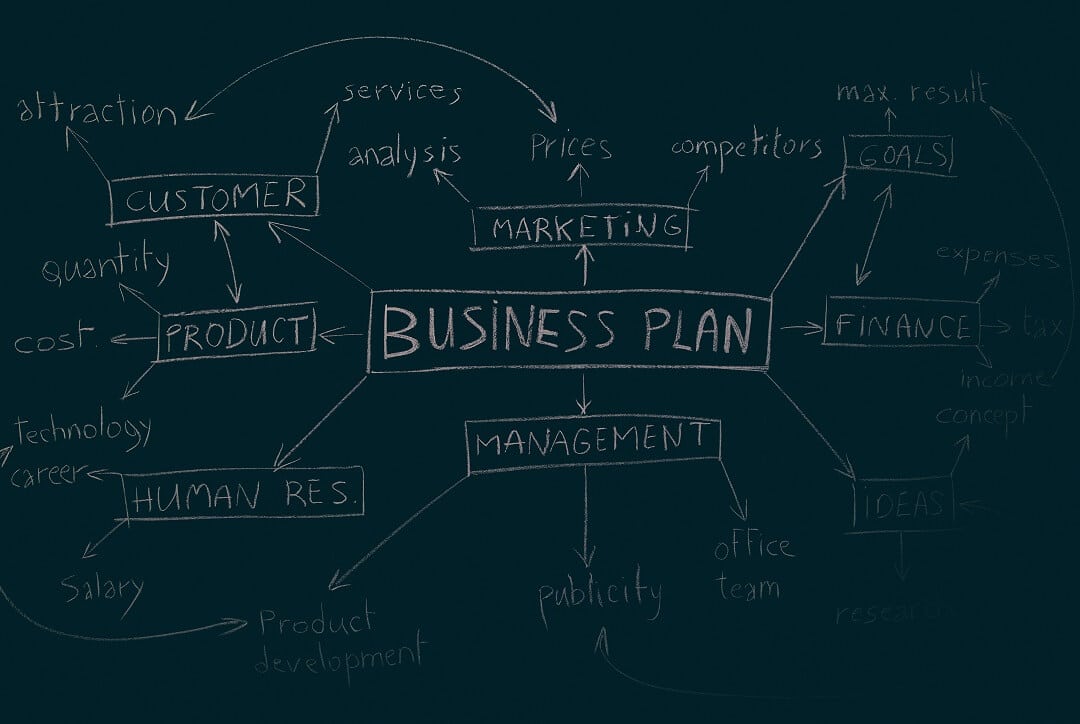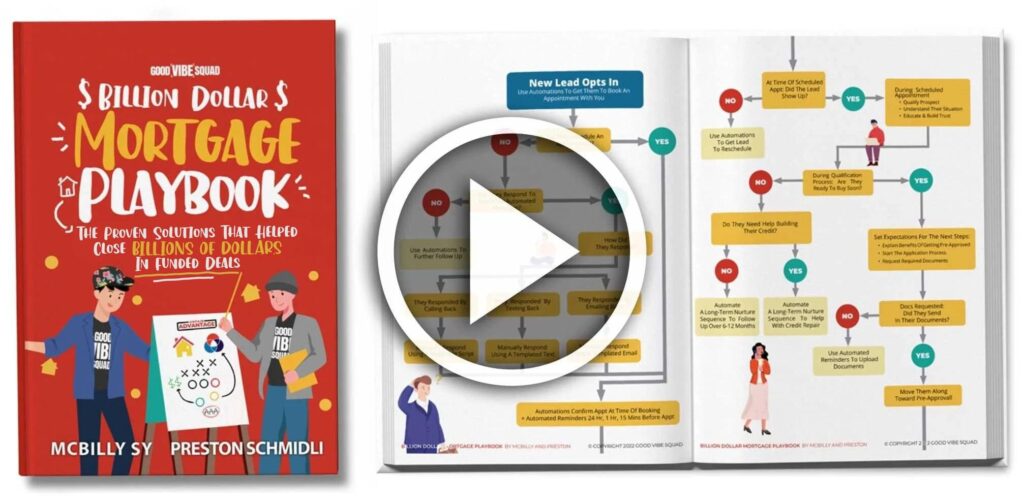Get Our Billion Dollar Mortgage Playbook
Get the proven strategies that helped close Billions of dollars in funded deals!
Top loan officers in the mortgage industry do not reach their level of success without a business plan in place. Whether you are a new loan officer or a seasoned professional lender struggling to find the success you desire, creating and implementing a business plan gives you a clear roadmap to follow to reach your long-term vision. The more you focus on your business goals, the more likely you are to achieve them. Setting time aside each year to adjust your business plan allows you to adjust your strategies and objectives to the rapidly changing mortgage industry.
Key Takeaways
- Successful loan officers need a business plan to guide them towards their goals and navigate the changing mortgage industry.
- A loan officer’s business plan should define their target audience and market, establish SMART goals, identify daily actions and marketing strategies, create a networking strategy, and measure their campaigns.
- A loan officer’s business plan should include an executive summary, company analysis, industry analysis, customer analysis, competitive analysis, marketing and operations plans, management team, financial plan, and an appendix.
- Developing a comprehensive business plan will not only help loan officers achieve their business goals, but also provide them with a better understanding of the mortgage industry and how to stand out from their competitors.
What is a business plan?
A business plan begins by focusing on where your business is today. Next, it turns the focus to where you hope to be at the end of the next year, in five years, or further down the road. Within your business plan, you define your goals and your business strategies for reaching those goals, including research that supports the strategies that you choose. By creating a business plan, you will gain an in-depth understanding of the mortgage industry, your audience and market, and how to stand out above your competition.
Why do loan officers need a business plan?
Whether you are just starting out as a new loan officer or looking to grow your existing business, a structured business plan helps create a roadmap to success. It offers you a clear picture of what is today, what you hope tomorrow will bring, and the strategies you need to implement and follow in order to achieve the business goals you have in place.
How to create a loan officer business plan?
Before you begin creating a loan officer business plan, you need to thoroughly research and understand some key areas of your business. Gaining this knowledge will help you better understand your industry and your clients while also helping to establish realistic and attainable business goals to include in your business plan. Here are some key areas to focus on while starting your business plan.
1. Define your audience and target market
The best place to begin when creating a business plan is your audience. You need to establish who your potential clients are and define your specific niche. For example, if you focus on first-time home loans, your target audience may be millennials and younger homebuyers whereas if your niche is home refinancing, your target market may be older adults. Defining and understanding your niche and target market is necessary to complete other segments of your business plan.
2. Understand your business objectives and goals
When creating a business plan, another major component to consider is your business objectives and goals. You can’t grow your business without first determining your goals. When establishing your business goals, it is important to consider the SMART method. SMART stands for specific, measurable, achievable, relevant, and time-bound. Establishing goals based on these components will help you move forward with your business plan.
3. Identify daily action and marketing strategies
Once you have your target audience and goals defined, it is time to start creating your marketing strategy and daily objectives. When developing your marketing strategy, it is important to consider your target audience and where they are. For example, if your target audience is seniors, social media marketing strategies may not be as effective as they would be for a millennial-driven target audience.
Daily objectives are small, daily changes you can make to work towards your bigger business goals for the year. Putting these daily objectives into your regular routine help provide a roadmap toward your final destination.
4. Create a networking strategy
For loan officers and mortgage industry professionals, networking plays a vital role in business success. Developing a strategy to address how you will continue to grow and nurture your professional relationships with business and referral partners, such as realtors and real estate agents, is an important component of a successful business plan.
5. Measure your campaigns
Creating a great business plan is not effective if you don’t have a way to measure your efforts. Consider how you will measure different aspects of your business plan to gain a clear picture of what is working and what isn’t. Analytics through a quality CRM, Google Analytics, or other tracking software can help you gather and analyze data, giving you a greater insight into your efforts.

Components of a basic loan officer business plan template
Once you have data gathered, it is time to sit down and create a structured business plan. Here we highlight a standard business plan template to help walk you through the process and ensure you touch on every aspect of your business.
1. Executive summary
While a completed business plan begins with an executive summary, the fact is this section is often the last part you complete. This is because the executive summary provides a snapshot of every section within your business plan. Once you have every component in the template complete, you can structure your summary.
2. Company analysis
The company analysis is a detailed explanation of the type of mortgage loan business you are operating. As a mortgage loan officer or mortgage broker, it may seem obvious that you are offering home loans. However, while you may offer a wide selection of mortgage loan offerings, this is an area where you can highlight your niche and the types of loans you plan to focus on. In addition, this section should include a brief history of the business, such as when it was started, the legal structure, and the goals that the business has already achieved.
3. Industry analysis
In the industry analysis section, you want to provide an overview of the current mortgage industry. This will likely require research and may seem like an unnecessary part of a business plan. However, that could not be farther from the truth. By researching the industry, you educate yourself on new trends and requirements. This not only helps improve your knowledge and ability to show yourself as an industry leader, but it also helps you gain insight into what marketing and business strategies may prove more effective in the current market.
4. Customer analysis
The customer analysis section is where you put your target audience and market information. Here you break down and define your target audience based on demographic and psychographic profiles that can include everything from age and gender to income levels and employment. In addition, you want to use this space to identify the needs and wants of your target audience, making it easier to identify strategies later on in the business plan that will help you better address these wants and needs.
5. Competitive analysis
The competitive analysis section examines your direct and indirect competitors. Direct competitors are considered loan agents in your local area while indirect competitors are additional places where borrowers can acquire a mortgage, such as commercial banks. When creating this analysis, you want to focus on providing detailed information on each competitor that includes the types of loans they offer, their target audience, their strengths and weaknesses, and how your business compares with these answers.
6. Marketing and operations plans
Similar to the daily actions and marketing section above, the marketing and operations strategy plan section focuses on the marketing steps you plan to take to drive customers to your business and the daily actions you plan to take to best serve your customers. This can include in-depth information on the types of marketing you plan to invest in, such as social media and email campaigns, as well as how much you plan to invest in your marketing strategies.
The operations plan focuses on the tasks involved in implementing your marketing strategies, as well as the tasks required to meet your daily operational goals, such as processing loan applications. In addition, you want to lay out your long-term business goals and how and when you hope to achieve each goal.
7. Your management team
Here is where you highlight your key management team. If you are an independent loan officer without a team, here you will focus on your information, background, and the skills you bring to the table in order to help achieve the goals outlined in your business plan.
8. A financial plan
Your financial plan includes three main components: An income statement, a balance sheet, and cash flow statements. Your income statement, also known as a profit and loss statement, shows your revenue as well as your business costs in an effort to show whether you are turning a profit or not. In your business plan, you also want to set a goal for your business that addresses business growth and how much this growth will affect the income statement.
Your balance sheets show your business assets and liabilities while your cash flow statements show how much money you have available to help grow your business.
9. An appendix
The appendix of your business plan is a place to attach any supporting documents to other areas of your business plan. This can include everything from lease agreements for your office to industry trend reports or marketing plan outlines.
How adding a business plan can help offer direction
Focusing on these tips and the general business plan template will give you the backbone necessary to create an effective business plan that will provide you with a roadmap for your future. Take the time to thoroughly go through each step and research all the necessary information. Not only will this give you the tools you need to begin reaching your business goals, but it will also provide you with a greater understanding of the mortgage industry and what you need to do to rise above your competition.







